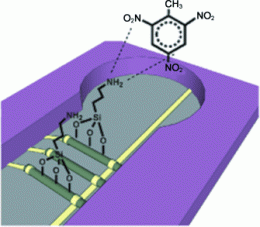Sniffer dog on a chip: Highly sensitive TNT detection with nanowires

(PhysOrg.com) -- To thwart possible terrorist attacks and to detect contamination on sites of former military installations, researchers have been concentrating their efforts in recent years on methods for the detection and analysis of explosives.
Fernando Patolsky and his team at the University of Tel Aviv have now developed a novel sensor chip that detects trinitrotoluene (TNT), as well as other explosive species, with high sensitivity and without a concentration step. As the Israeli researchers report in the journal Angewandte Chemie, their detector is superior to sniffer dogs and all other previous detection methods for this explosive.
The difficulty with the detection of explosives such as TNT is their extremely low volatility. Methods available for the analysis of air samples are expensive and time-consuming, and require large, bulky instruments, laborious sample preparation, and expert handling. “There is a need for an inexpensive, miniaturizable method that allows for quick, easy, and robust high-throughput analysis in the field,” says Patolsky.
The scientists built their sensor using the principle of a nanoscale field-effect transistor. In contrast to a current-controlled classical transistor, a field-effect transistor is switched by means of an electric field. At the core of the device are nanowires made of the semiconductor silicon. These were coated with a molecular layer made from special silicon compounds that contains amino groups (NH2). TNT molecules bind to these amino groups in the form of charge-transfer complexes. The binding process involves the transfer of electrons from the electron-rich amino groups to the electron-poor TNT. This change in the charge distribution on the surface of the nanowires modulates the electric field and leads to an abrupt change in the conductivity of the nanowires, which is easily measured.
To improve the signal-to-noise ratio and thus increase the sensitivity, the scientists equipped their chip with an array of about 200 individual sensors. “We are thus able to analyze liquid and gaseous samples without prior concentration or other sample preparation at previously unattainable sensitivities,” says Patolsky. “We were able to analyze concentrations down to 0.1 ppt (parts per trillion); that is, one molecule of TNT in 10 quadrillion other molecules.” The sensor can be quickly regenerated by washing and is selective for TNT; other related molecules do not react the same way.
“We are now creating a chip based on large arrays of nanosensors chemically modified with a large number of chemical receptors, with different binding capabilities, in order to detect a whole spectrum of explosive species in parallel,” says Patolsky.
More information: Fernando Patolsky, Supersensitive Detection of Explosives by Silicon Nanowire Arrays, Angewandte Chemie International Edition 2010, 49, No. 38, 6830-6835, dx.doi.org/10.1002/anie.201000847
Provided by Wiley


















